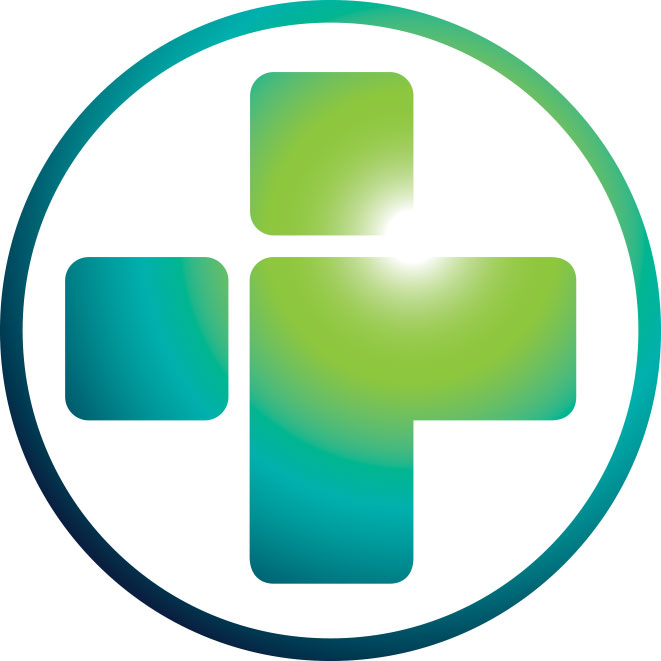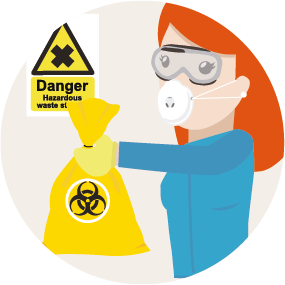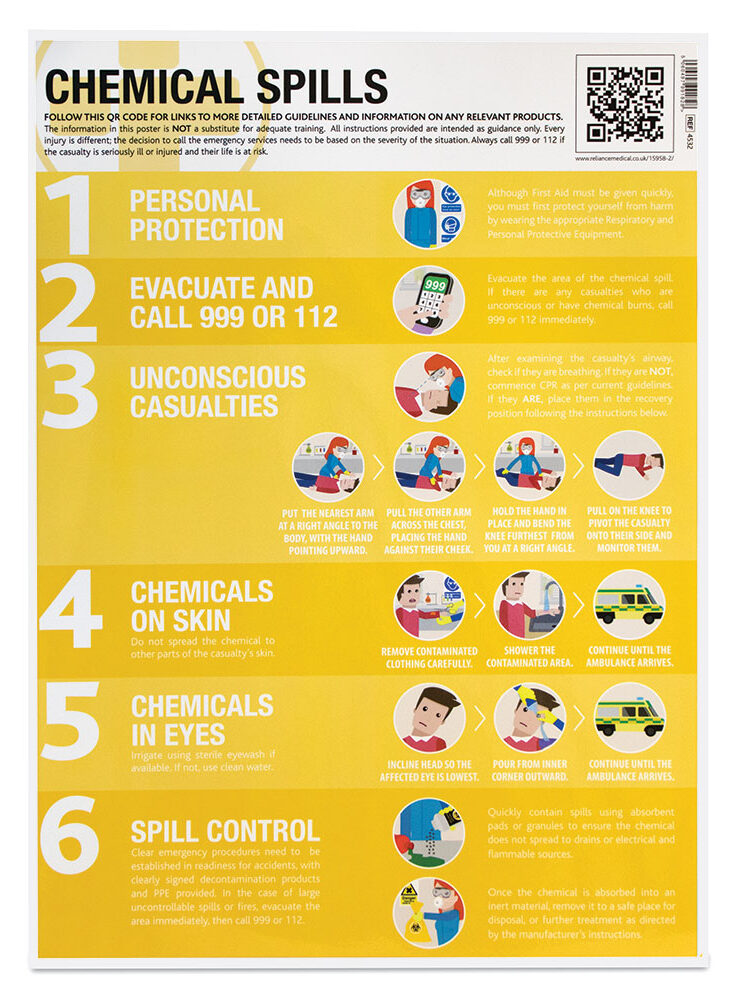Chemical Spills
Additional material to support your workplace poster, with a quiz to test your knowledge.
Unresponsive Casualties of Chemical Spills
1. PERSONAL PROTECTIVE EQUIPMENT
If you find a casualty that you suspect needs First Aid due to a Chemical Spill injury, you must first put on your Personal Protective Equipment (PPE). Although First Aid should be administered to any casualties as soon as possible, the first consideration must be to protect yourself from harm. The appropriate PPE will depend on the type of injury and chemical. This may require using a resuscitation shield if there are chemicals on the casualty’s face.
You also need to make sure that the environment around you is safe.
2. CHECK FOR A RESPONSE
Check if the casualty is conscious by calling their name and shaking their shoulders gently. You should also shout for somebody to help you. If someone can help, ask them to call the Emergency Services and locate an AED while you prioritise checking the casualty’s ABC’s (Airway, Breathing, and Circulation (CPR).
3. CALL 999 OR 112
If someone has responded and has arrived to help, ask the helper to call and talk to the Emergency Services, otherwise, call them yourself. If possible, stay with the victim while making the call. If there is a hands-free speaker function on the phone, it can be activated to include communication with the Ambulance Service while you begin CPR.
4. EXAMINE AIRWAY
Check inside the casualty’s mouth for any obstructions. If the airway is clear, turn the victim onto their back (if they are not already on it). Gently tilt the head back, then, with your fingertips under the point of the victim’s chin, lift their chin to open the airway.
5. CHECK BREATHING
Look, listen, and feel for normal breathing for no more than 10 seconds. In the first few minutes after Cardiac Arrest, a victim may be barely breathing, or just taking infrequent, slow, and noisy gasps. Do not confuse this with normal breathing. If you have any doubt whether breathing is normal, act as though it is not and prepare to start CPR.
6. IF THE CASUALTY IS NOT BREATHING, ADMINISTER CPR
GIVE 30 COMPRESSIONS
Kneel by the side of the victim and place the heel of one hand in the centre of the victim’s chest (this is the lower half of the victim’s breastbone/sternum. Place the heel of your other hand on top of the first hand, then interlock your fingers. Ensure that pressure is not applied over the victim’s ribs. Keep your arms straight. Do not apply any pressure over the upper abdomen or the bottom end of the bony sternum (breastbone). Position your shoulders vertically above the victim’s chest and press down on the sternum to a depth of 5–6 cm (approximately a third of the depth). After each compression, release all the pressure on the chest without losing contact between your hands and the sternum. Repeat 30 times at a rate of 100–120 compressions per minute.
GIVE 2 RESCUE BREATHS
After 30 compressions, open the airway again by using the head tilt and chin lift manoeuvre (as above), and give 2 rescue breaths. To give rescue breaths, pinch the soft part of the nose to close the nostrils by using the index finger and thumb of your hand that is on their forehead. Allow the mouth to open, but maintain the chin lift. Take a normal breath and place your lips around their mouth, making sure that you have a good seal. Blow steadily into the mouth while watching for the chest to rise, taking about 1 second as in normal breathing; this is an effective rescue breath.
Maintaining head tilt and chin lift, take your mouth away from the victim and watch for the chest to fall as air comes out, then take another normal breath and blow into the victim’s mouth once more to achieve a total of two effective rescue breaths. Do not interrupt compressions by more than 10 seconds to deliver two breaths. Then return your hands without delay to the correct position on the sternum and give a further 30 chest compressions.
GIVE 30 MORE COMPRESSIONS
Continue with chest compressions and rescue breaths at a ratio of 30:2. If you are untrained or unable to do rescue breaths, give chest-compression-only CPR (i.e. continuous compressions at a rate of at least 100–120 per minute).
If you are unable to perform mouth-to-mouth resuscitation, perform citizen CPR. Push hard and fast in the centre of the chest. Don’t stop until help arrives.
For more information on CPR, visit the Resuscitation Council’s website.
7. IF THE CASUALTY IS BREATHING, PUT THEM INTO THE RECOVERY POSITION.
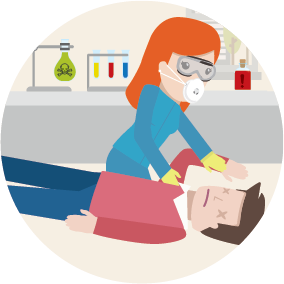
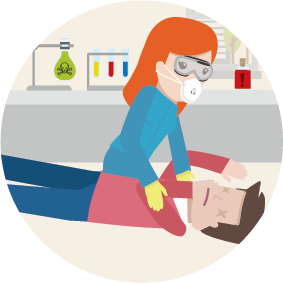
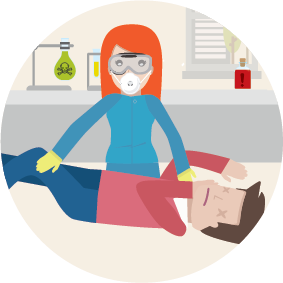
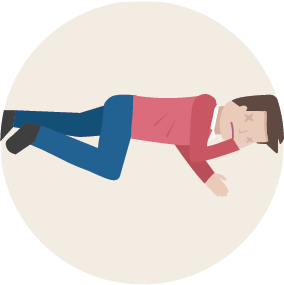
N.B. If you suspect the casualty may have a spinal injury, DO NOT attempt to move them until the Emergency Services reach you.
Chemical Decontamination of the Skin
First Aid measures for substances and mixtures can be found in Section 4 of the products Safety Data Sheet.
Information for appropriate PPE can be found in section 8 of the Safety Data Sheet.
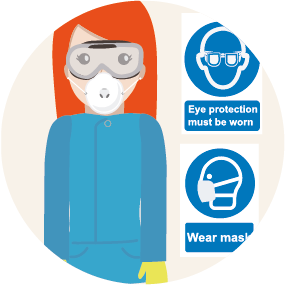
1. WEAR APPROPRIATE PERSONAL PROTECTIVE EQUIPMENT (PPE).
Before approaching a casualty that has chemical burns, you must first protect yourself by wearing the appropriate Respiratory and Personal Protective Equipment, (RPE and PPE).

2. IF NEEDED, CALL 999 OR 112 IMMEDIATELY
Call 999 or 112 if the chemical burn is severe. The decision to call the Emergency Services should be based on the severity of the situation. If more than one person is present, one person should call the ambulance while the other begins to administer First Aid.
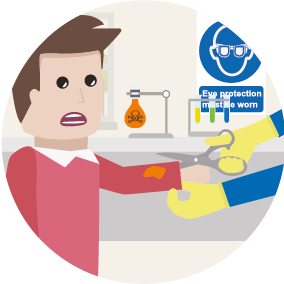
3. REMOVE ANY CONTAMINATED CLOTHING
Carefully remove any contaminated clothing from the area that has been affected by the chemical. Take care not to further contaminate any part of the casualty’s body when removing clothing. If the casualty is unconscious or the clothing is awkward to remove, you may have to use scissors to cut away the clothing.
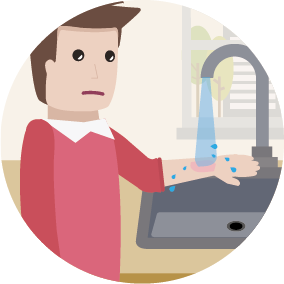
4. SHOWER THE CONTAMINATED AREA
Drench the affected area with clean, uncontaminated water for at least 20 minutes or more, ensuring that any contamination is not spread while doing so. If the casualty is unconscious, they may have to be hosed down where they are. Try to keep the patient warm while the chemical burn is being cooled. Use a blanket or an item of clothing to keep the rest of their body warm.
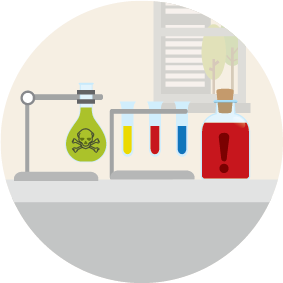
5. IDENTIFY THE CHEMICAL
Identify the chemical that has caused the burn. This may provide vital information for healthcare professionals treating the burn. It is also good practice to collect the Safety Data Sheets for the chemical. Reading the labels on the packaging may give you more information on how to treat the burn, as well as listing emergency contact numbers such as the manufacturer and poison control centres etc.
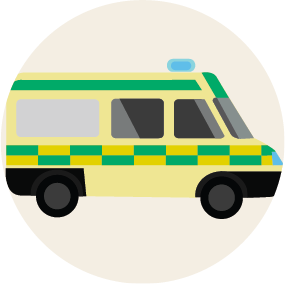
6. IF YOU DID NOT CALL AN AMBULANCE, GO TO A&E IMMEDIATELY
Treat ALL chemical burns as serious. If the situation was not severe enough for you to call an ambulance, then go to your nearest Accident and Emergency Department to get further treatment. Take any Safety Data Sheets, labelling, or packaging with you.
Chemical Decontamination of the Eyes

1. WEAR APPROPRIATE PERSONAL PROTECTIVE EQUIPMENT (PPE).
Before helping a casualty that has chemical contamination of the eyes, you must first protect yourself from harm by wearing the appropriate Personal Protective Equipment.
2. IF NEEDED, CALL 999 OR 112
Call 999 or 112. The decision to call the emergency services should be based on the severity of the situation. If more than one person is present, one of you should call for an ambulance, while the other begins administering First Aid.
3. IRRIGATE THE EYE
If a casualty has chemicals in their eye, you need to irrigate the eye as quickly as possible. Seat the casualty in a comfortable position with their head tilted, so that the affected eye is lower than the other.
Gently hold their eye open and irrigate the whole eye, ensuring that you also irrigate under the eyelid. Buffered Phosphate Solution offers a better chance of saving an eye than standard Sodium Chloride (Saline), Eye Wash. As well as diluting and flushing out the eye, the Phosphate has a neutralising effect on alkali and acid, (the effect is generally stronger on alkalis than acids). This helps to restore PH levels of the eye back to normal.
However, if Phosphate Solution is unavailable, use either Saline Eye Wash, fresh water from a clean container, or cool water straight from the tap. Flush the chemical from the eye with copious amounts of liquid. If using Sterile Eye Wash, check that the bottle is sealed, within the expiry date, and ensure the contents are clear before using them. If using tap water, make sure the temperature is cool, not warm, and only use a container that is completely clean.
During the irrigation process, be careful to protect the unaffected eye from chemical contamination resulting from splashing.
Wash the eye thoroughly by pouring water repeatedly from the inner corner of the eye outward, for 10 seconds at a time, allowing the casualty to blink in-between.
Continue this procedure for 20 minutes or more, or until the ambulance arrives.
4. IDENTIFY THE CHEMICAL
Identify the chemical that has caused the burn. This may provide vital information for healthcare professionals treating the burn. It is also good practice to collect the Safety Data Sheets for the chemical. Reading the labels on the packaging may give you more information on how to treat the burn, as well as listing emergency contact numbers such as the manufacturer and poison control centres etc.
5. GO TO A&E IF YOU DID NOT CALL AN AMBULANCE
Treat ALL chemical burns as serious. If the situation was not severe enough for you to call an ambulance, then go to your nearest Accident and Emergency Department to get further treatment. Take any Safety Data Sheets, labelling, or packaging with you.
Employer Responsibilities
1. EMERGENCY PLAN
To prepare for spills you should: Learn about the hazards from the chemicals in your workplace, make written response procedures to address those hazards, and ensure that you have the equipment and training necessary to follow those procedures.
2. KNOW THE HAZARDS
You need to identify the hazardous, or potentially hazardous properties, of all the chemicals used or produced in your workplace. Before using any chemicals, you should evaluate the consequences of potential spills and develop appropriate response procedures. Consult published data in Material Safety Data Sheets or Chemical Dictionaries for information on response planning.
3. OUTLINE SPILL RESPONSE PROCEDURES
Every workplace that uses chemicals should prepare a written spill response procedure. Such procedures should detail the initial steps to be taken when a spill occurs, and include such elements as staff responsibilities, communication methods, instructions on using spill response equipment, spill clean-up, and residue disposal.
Communicate these procedures to all individuals that use chemicals or who might assist during spill clean-up. Periodically review and update these procedures and ensure that all workers are familiar with the current information.
Spill response procedures should include elements such as:
A listing of appropriate protective clothing, safety equipment, and clean-up materials required for spill clean-up (gloves, respirators, etc.), and an explanation of their proper use.
Appropriate evacuation zones and procedures.
Availability of fire suppression equipment.
Disposal containers for spill clean-up materials.
The first aid procedures that might be required.
4. HAVE MATERIALS AND EQUIPMENT READILY AVAILABLE IN AN EMERGENCY
Before starting any work with chemicals, make certain that all necessary safety equipment and spill clean-up materials are available and in good working order. Additionally, ensure that the individuals who may be involved in spill response are properly trained in equipment use and spill clean-up procedures. Regularly inspect and maintain all materials and equipment, to ensure they will function properly when needed.
5. IF A SPILL OCCURS
In the case of large uncontrollable spills or fires, evacuate the area immediately.
Contain and control the incident quickly to minimise the effects, and to limit danger to other workers and the environment. If the spill is a liquid, use absorbent pads to ensure the spillage doesn’t spread to drainage or electrical/flammable sources.
The chemical substance should be absorbed by using an inert carrier material. This allows the contaminant to be cleared up and removed to a safe place for disposal or further treatment as appropriate.
Complete an in-depth risk assessment, and implement measures needed to prevent future spillages from happening.
Chemical Spills Quiz
A short quiz to test your knowledge of Chemical Spills First Aid
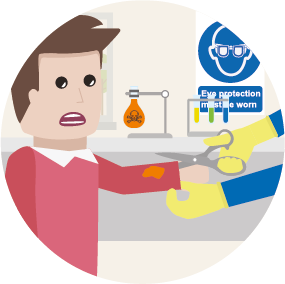
All information is for guidance only and correct at time of publication.

